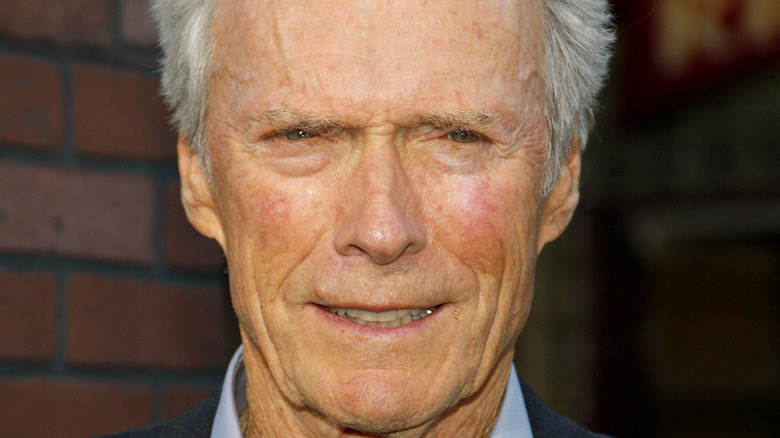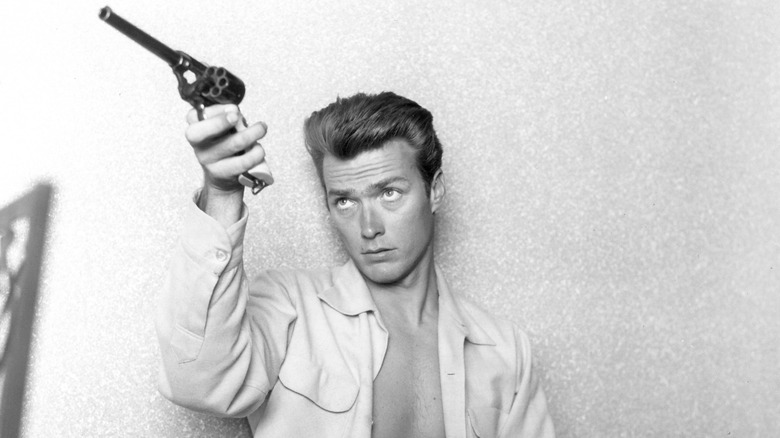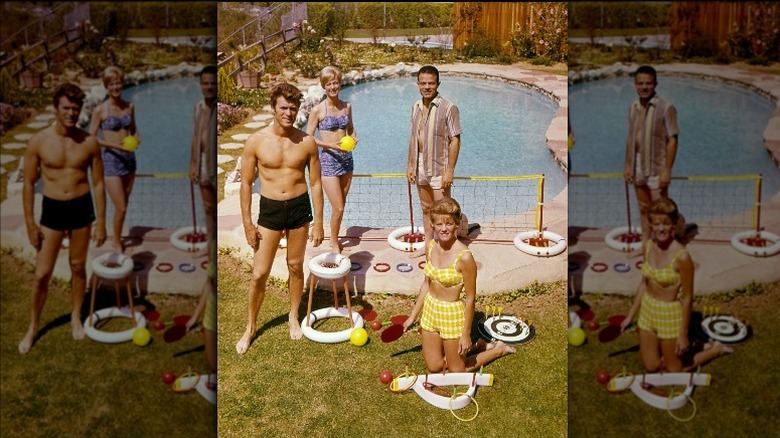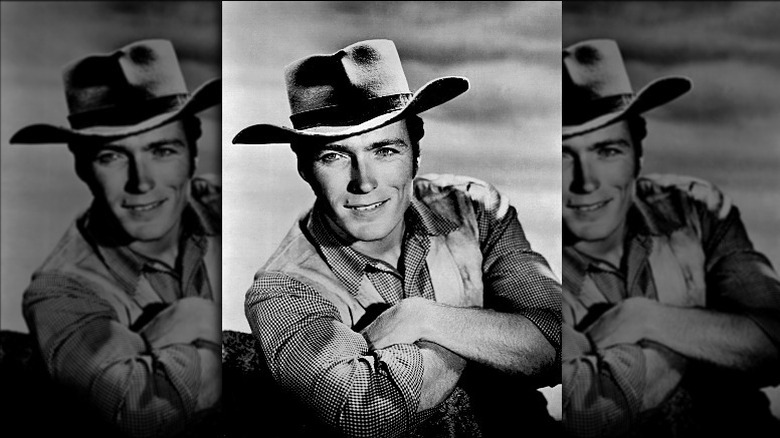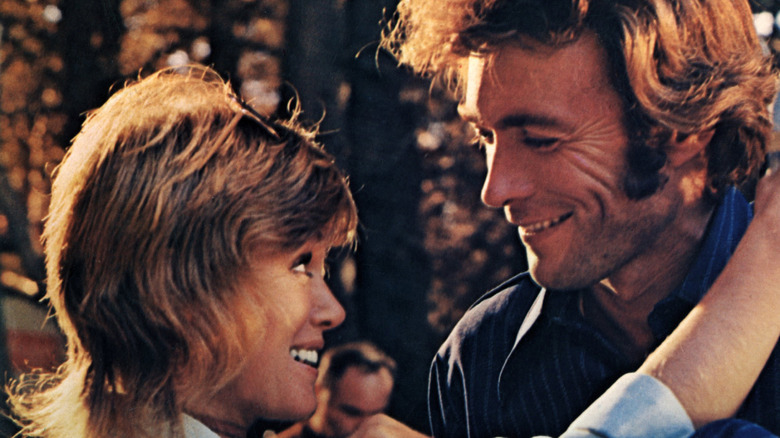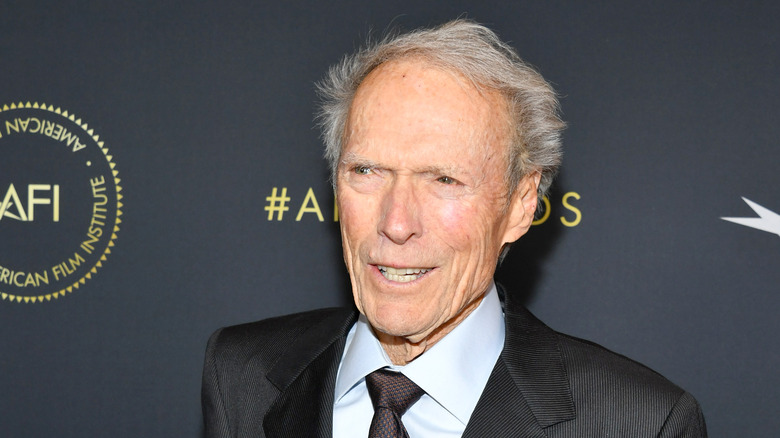The Transformation Of Clint Eastwood From 21 To 90
Clint Eastwood is a staple of American film history, both in front of and behind the cameras. The actor has proved to have a talent not only for portraying handsome, lonesome cowboys but also for seamlessly transitioning into directorial and producing roles while staying just as relevant — if not more.
After bursting onto the silver screen in popular Westerns in the 1960s and 1970s, Eastwood forever cemented his place among America's cool dudes. In fact, a 2010 survey commissioned by Esquire that asked men in their 20s and in their 50s to vote for America's coolest man put Eastwood right at the top among both age groups, proving that, while some things have changed rather fast around us, Eastwood's reputation has remained steadfast — even among folks who weren't born when he was shooting his gun on TV.
While Eastwood's Western days shot him to stardom, they hardly define his career. Eastwood has found great success as a director, a role for which he has been recognized with a series of accolades. He won Best Director and Best Picture twice, for a total of four Academy Awards with "Unforgiven" and "Million Dollar Baby," the latter of which also earned him a nomination for Best Actor, his third nomination in the category after "Mystic River" and "Letters from Iwo Jima."
With a career spanning nearly 70 years, Eastwood has spent most of his life in the limelight, changing and evolving alongside American culture. Keep scrolling to check out his transformation over the decades.
Clint Eastwood started acting while serving in the U.S. Army
Clint Eastwood's acting career started in the most unlikely of places: the U.S. Army. The San Francisco native was drafted in 1951 to serve in the Koran War and spent the following couple of years stationed at the now-closed Fort Ord post in California. It was during this time as an army swimming instructor and lifeguard that a film producer first caught sight of the 6-foot-4 handsome 20-something, as Mashable noted. Universal Studios had chosen the military post as a filming location, and Eastwood's striking good looks didn't go unnoticed.
While Eastwood's muscular body, square jaw, and baby blue eyes were unquestionable, his acting skills were not. "He was quite amateurish. He didn't know which way to turn or which way to go or do anything," said producer and director Arthur Lubin, known for his "Abbott & Costello" films, "Phantom of the Opera" (1943), and other classics. Eastwood's own opinion wasn't very different. "I thought I was an absolute clod. It looked pretty good, it was photographed well, but I thought, 'If that's acting, I'm in trouble," he said, as quoted in "American Rebel: The Life of Clint Eastwood."
But Lubin saw potential in the young man and arranged for him to take drama lessons. Lubin went on to give Eastwood his very first contract in 1954, which led to uncredited roles in horror and sci-fi films, such as "Tarantula" and "Revenge of the Creature," per Esquire.
In the 1950s, Clint Eastwood juggled his slow career and a difficult marriage
Clint Eastwood's career continued along a similar path throughout the 1950s as he worked for Universal. In 1955, he landed a role in his first feature film when he played the part of a sailor in "Francis in the Navy," though his wasn't the main role, per Marc Eliot's book "American Rebel: The Life of Clint Eastwood. In 1955, as he continued to pick up small parts, his contract with Universal was terminated, which left him no options but to look for another job, per Esquire. According to Your Dictionary, Eastwood found work digging swimming pools in the late 1950s, a job he had previously done before he got into acting.
At the same time, Eastwood was trying to juggle his career with a struggling marriage. In 1953, shortly after being discharged from the army, Eastwood met Maggie Johnson on a blind date and married her just six months later, per ABC News. Though his career wasn't blossoming yet, Eastwood was enjoying the attention he was getting from women, which got in the way of his marriage, according to "American Rebel: The Life of Clint Eastwood. "The first year of marriage was terrible. If I had to go through it again, I think I'd be a bachelor for the rest of my life. I liked doing things when I wanted to do them," he admitted. They officially divorced in 1984, nine years into Eastwood's relationship with Sondra Locke, per ABC.
Clint Eastwood's career took a turn upwards after 'Rawhide'
Clint Eastwood had his much sought-after breakthrough in 1958, when he was cast to bring Rowdy Yates to life in the CBS Western series "Rawhide," a character he went on to play for seven years. While the role catapulted him into fame, it also proved limiting for the ambitious actor. According to Reader's Digest, Eastwood often called his character "Rowdy Yates, idiot of the plains." Still, the hit series gave him considerable visibility. In fact, his performance in the November 1961 episode "Incident of the Black Sheep" caught Sergio Leone's attention, according to James L. Neibaur's book "The Clint Eastwood Westerns."
Leone wanted a bigger name to star in "A Fistful of Dollars," a low-budget Western shot in Italy, though it isn't hard to see why most of the big shots weren't particularly interested. So, Eastwood accepted the challenge, motivated in part by a desire to leave behind the monotony of playing the same character day in and day out, per Neibaur. It was a risky move, considering that Italian movies had little to no viewership in the U.S., but it proved to be one worth taking.
"I was this young man, having done three years on 'Rawhide,' with an Italian director who spoke no English. I thought it was insanity and that insanity was intriguing for me," Eastwood said, according to Empire. The movie and Eastwood's Man With No Name helped give rise to the popular so-called Spaghetti Westerns.
Clint Eastwood had his directorial debut in the early 1970s
After finding immense success in Sergio Leone's Spaghetti Westerns and other similarly themed films throughout the 1960s, Clint Eastwood began to show his depth and branching skills in the early 1970s with his directorial debut. When the cult psychological thriller "Play Misty for Me" came out in 1971, the late film critic Robert Ebert predicted Eastwood was on the right path. "Clint Eastwood, in directing himself, shows that he understands his unique movie personality. He is strong but somehow passive, he possesses strength but keeps it coiled inside."
In 1973, the first Western directed by Eastwood, "High Plains Drifter," hit theaters, proving he would continue to make history in the genre viewers had fallen in love with him in. "It was always at the back of my mind there was going to come a day when I would direct," Eastwood said, according to Empire. "But it came simply, I did one picture, then I needed to do a Western picture because that's the genre I was brought up in so I did. Then one thing led to another and 28 years later I'm still doing it."
About 20 years later, Eastwood snagged his first Best Director Academy Award with "Unforgiven," which also won Best Picture and starred Gene Hackman, Morgan Freeman and Richard Harris — in addition to himself. "[H]e looks even taller, leaner and more mysteriously possessed than he did in Sergio Leone's seminal 'Fistful of Dollars'," The New York Times noted.
At 90, Clint Eastwood continues to work in films
The public has become so accustomed to the idea that Clint Eastwood is an iconic actor and also a highly respected director that the feat seems natural, but it really isn't. As The New Yorkers' David Denby put it, most of Hollywood's great actors who dabbled in directing have by and large failed, including Paul Newman, Jack Nicholson, Warren Beatty, Robert Redford, among others. "Eastwood, by experimenting with new forms and moods, both light and dark, and by constantly altering his early self as a star, achieved both as he got older, and without becoming a stiff," Denby wrote.
After directing more than 30 films, Eastwood, who will celebrate his 91st birthday on May 31, 2021, is still at it. In 2020, he directed and performed in "Cry Macho," which is set to be released in 2021, as Variety reported. As he has proved over and over again, Eastwood has no plans to retire. "I just enjoy working," Eastwood said on The Ellen DeGeneres Show. "I think I've been lucky enough to work in a career that I've enjoyed... and a lot of people can't say that."
As a director, Eastwood has made a name for himself for bringing out the best in people. As Gene Hackman told Reader's Digest, "So many directors are busy running around, trying to show off their authority. Clint's not like that. He's a great listener, and he approaches everything in a practical way."

